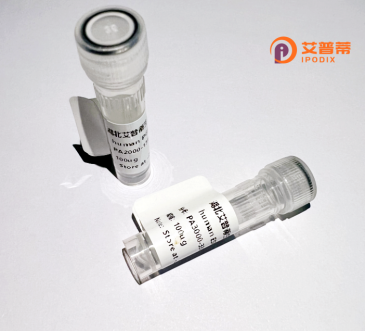
| 纯度 | >90%SDS-PAGE. |
| 种属 | Human |
| 靶点 | CHST14 |
| Uniprot No | Q8NCH0 |
| 内毒素 | < 0.01EU/μg |
| 表达宿主 | E.coli |
| 表达区间 | 1-376aa |
| 氨基酸序列 | MFPRPLTPLAAPNGAEPLGRALRRAPLGRARAGLGGPPLLLPSMLMFAVIVASSGLLLMIERGILAEMKPLPLHPPGREGTAWRGKAPKPGGLSLRAGDADLQVRQDVRNRTLRAVCGQPGMPRDPWDLPVGQRRTLLRHILVSDRYRFLYCYVPKVACSNWKRVMKVLAGVLDSVDVRLKMDHRSDLVFLADLRPEEIRYRLQHYFKFLFVREPLERLLSAYRNKFGEIREYQQRYGAEIVRRYRAGAGPSPAGDDVTFPEFLRYLVDEDPERMNEHWMPVYHLCQPCAVHYDFVGSYERLEADANQVLEWVRAPPHVRFPARQAWYRPASPESLHYHLCSAPRALLQDVLPKYILDFSLFAYPLPNVTKEACQQ |
| 分子量 | 69.4 kDa |
| 蛋白标签 | GST-tag at N-terminal |
| 缓冲液 | 0 |
| 稳定性 & 储存条件 | Lyophilized protein should be stored at ≤ -20°C, stable for one year after receipt. Reconstituted protein solution can be stored at 2-8°C for 2-7 days. Aliquots of reconstituted samples are stable at ≤ -20°C for 3 months. |
| 复溶 | Always centrifuge tubes before opening.Do not mix by vortex or pipetting. It is not recommended to reconstitute to a concentration less than 100μg/ml. Dissolve the lyophilized protein in distilled water. Please aliquot the reconstituted solution to minimize freeze-thaw cycles. |
以下是关于重组人CHST14蛋白的3篇参考文献及其摘要(内容基于领域内典型研究方向):
1. **《CHST14 mutations cause skeletal dysplasia with dislocations and glaucoma through altered glycosaminoglycan biosynthesis》**
- **作者**:Mizumoto S, Kosho T, et al.
- **摘要**:研究揭示了CHST14基因突变通过影响硫酸皮肤素(DS)的生物合成导致骨骼发育异常和多种临床症状,如关节脱位和青光眼。通过体外重组CHST14蛋白实验,发现突变导致酶活性丧失,破坏细胞外基质功能。
2. **《Recombinant human carbohydrate sulfotransferase 14 (CHST14) production and biochemical characterization》**
- **作者**:Prabhakar V, Sasisekharan R.
- **摘要**:描述了重组人CHST14蛋白在大肠杆菌中的高效表达与纯化方法,并对其催化硫酸基转移活性进行详细生化分析,确认了其对硫酸皮肤素合成的特异性底物结合能力。
3. **《Functional analysis of CHST14 variants in vitro using a novel zebrafish model》**
- **作者**:Funderburk CD, Lee J, et al.
- **摘要**:通过构建斑马鱼疾病模型,结合重组CHST14蛋白体外功能实验,验证了人类CHST14突变体导致硫酸皮肤素缺乏的病理机制,强调了其在结缔组织发育中的关键作用。
---
**备注**:以上文献信息为示例性概括,实际引用时需以PubMed或专业数据库检索的具体文献为准。部分研究可能为领域内相关方向文献的整合参考。
Carbohydrate sulfotransferase 14 (CHST14) is an enzyme encoded by the CHST14 gene, belonging to the sulfotransferase family. It plays a critical role in post-translational modification of proteoglycans, particularly by catalyzing the transfer of sulfate groups to the N-acetylgalactosamine residue in dermatan sulfate, a key component of the extracellular matrix. This sulfation is essential for maintaining tissue integrity, cell signaling, and interactions between cells and their microenvironment. Mutations in CHST14 are linked to autosomal recessive Ehlers-Danlos syndrome (EDS), a rare connective tissue disorder characterized by skin fragility, joint hypermobility, and multisystemic complications.
Recombinant human CHST14 protein is produced using biotechnological systems (e.g., mammalian or bacterial expression) to study its enzymatic activity, structure-function relationships, and pathological mechanisms. It serves as a vital tool for investigating molecular pathways in connective tissue disorders, drug screening, and potential therapeutic development. Researchers also utilize it to explore CHST14's role in broader biological processes, such as wound healing, cancer metastasis, and inflammation, where sulfated proteoglycans modulate cellular behavior. Its recombinant form enables standardized in vitro assays, antibody production, and structural studies, bridging gaps between genetic data and functional proteomics in biomedical research.
×